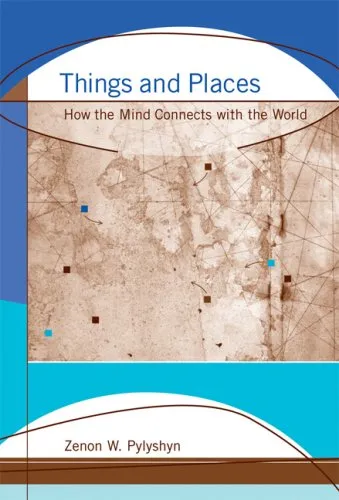Things and Places: How the Mind Connects with the World
4.3
Reviews from our users

You Can Ask your questions from this book's AI after Login
Each download or ask from book AI costs 2 points. To earn more free points, please visit the Points Guide Page and complete some valuable actions.Introduction to "Things and Places: How the Mind Connects with the World"
"Things and Places: How the Mind Connects with the World" is a profound exploration of a central question in cognitive science: How do we mentally represent, remember, and engage with the spatial layout of our environment? Authored by the eminent cognitive scientist Zenon W. Pylyshyn, this groundbreaking book delves into the intricate processes that allow our minds to connect with the external world, specifically focusing on how we perceive and keep track of objects and places around us. Through a multidisciplinary lens combining psychology, philosophy, neurobiology, and computational modeling, Pylyshyn offers meticulous insights into the mental mechanisms that underpin our interaction with the spatial aspects of our world.
Detailed Summary of the Book
Zenon W. Pylyshyn presents an in-depth analysis of the foundational processes that underlie spatial cognition. He introduces the concept of "Visual Indexing," which posits that the brain uses a set of pointers, or indexes, to track objects in our visual field. This idea is central to understanding how we can focus on specific elements within our environment while ignoring others, a process crucial for navigating complex spaces.
The book discusses various phenomena such as how attention is allocated, the continuity of perception despite changing perspectives, and the way we can remember the location of objects without constant visual input. Pylyshyn integrates empirical research with theoretical models, providing evidence from both experimental psychology and neurological studies. Key topics include the role of eye movements in perception, the distinction between allocentric and egocentric spatial representations, and how these are influenced by visual and non-visual information.
By exploring these themes, "Things and Places" offers a comprehensive framework that challenges traditional views of perception and cognition, emphasizing the non-conceptual nature of spatial information processing. Pylyshyn's work contributes significantly to our understanding of the mind's ability to interact with and represent the spatial world.
Key Takeaways
- The Visual Indexing Theory provides a new way to understand how the brain tracks objects without needing a detailed representation of the entire visual scene.
- Spatial cognition is not merely a result of visual input but involves independent processes that allow for the perception and memory of the environment.
- The book emphasizes the non-conceptual nature of spatial perception, suggesting that understanding and navigating our world does not always involve abstract thinking.
- Pylyshyn bridges the gap between philosophical perspectives on perception and empirical findings from cognitive science and neuroscience.
Famous Quotes from the Book
"The way we engage with the world, especially with things and places, depends on a set of cognitive mechanisms that operate beyond our conscious awareness."
"Our ability to navigate the physical world relies fundamentally on an implicit understanding that is not reducible to verbal or conceptual knowledge."
Why This Book Matters
"Things and Places" serves as a crucial text for anyone interested in cognitive science, psychology, or philosophy. Its innovative perspective on spatial perception and cognition challenges conventional theories and presents new directions for research and understanding. Zenon W. Pylyshyn's insights into the interaction between perceptual experience and cognitive processes provide valuable contributions to ongoing discussions about the nature of consciousness and how we mentally construct our experiential world.
By elucidating the mechanisms of spatial cognition, this book not only enhances our knowledge of human perception but also informs practical applications such as designing user-friendly technology interfaces, improving navigational aids, and understanding spatial disorders. "Things and Places: How the Mind Connects with the World" is a seminal work that deepens our comprehension of the human mind's profound capabilities.
Free Direct Download
You Can Download this book after Login
Accessing books through legal platforms and public libraries not only supports the rights of authors and publishers but also contributes to the sustainability of reading culture. Before downloading, please take a moment to consider these options.
Find this book on other platforms:
WorldCat helps you find books in libraries worldwide.
See ratings, reviews, and discussions on Goodreads.
Find and buy rare or used books on AbeBooks.
1233
بازدید4.3
امتیاز50
نظر98%
رضایتReviews:
4.3
Based on 0 users review
"کیفیت چاپ عالی بود، خیلی راضیام"


